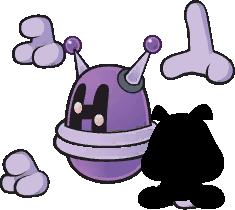

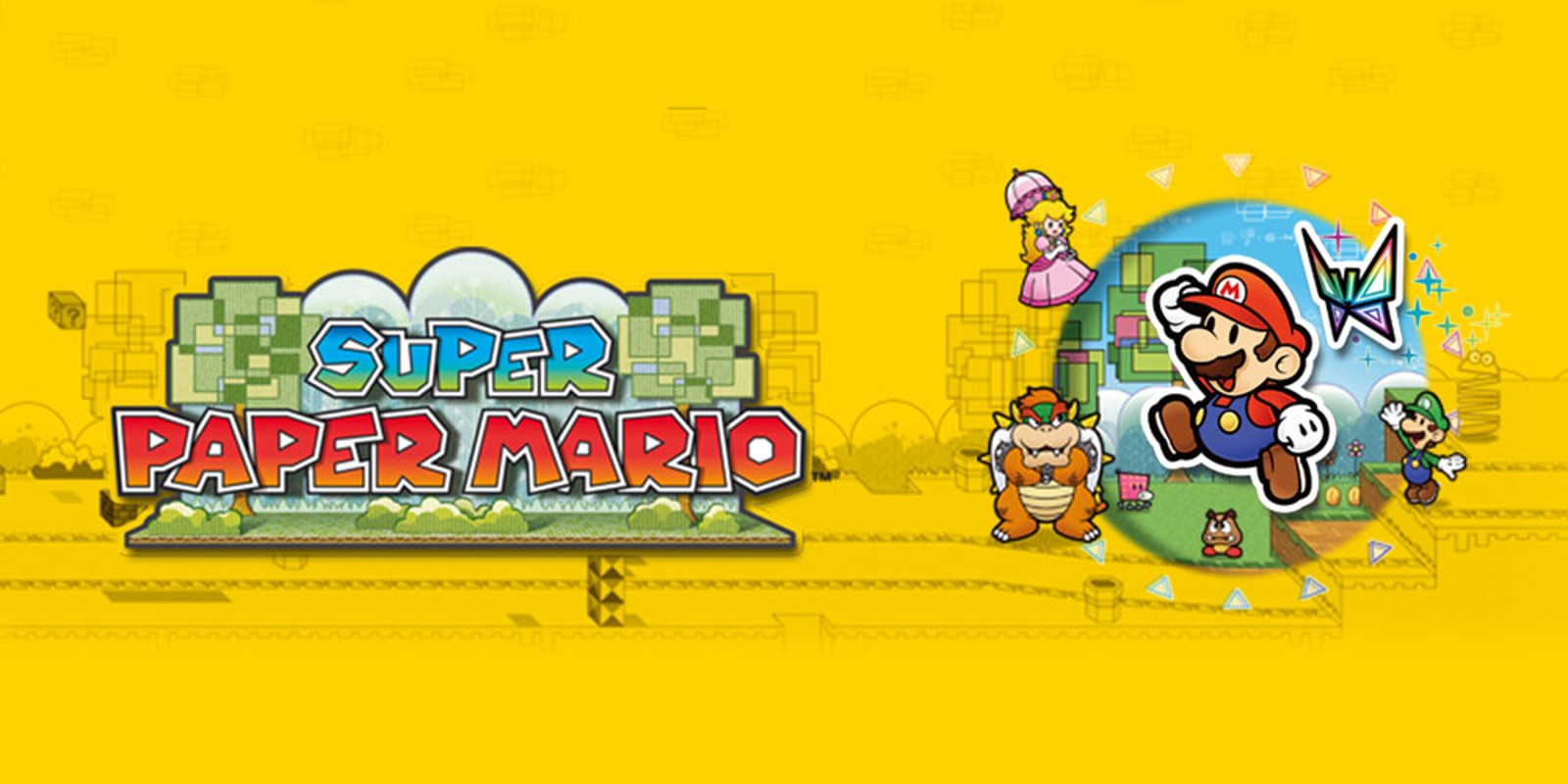
Paper Mario is a RPG or turn-based adventure spinoff of the Mario franchise, debuting on the Nintendo 64 in 2001. The series has always evolved with each game, though sometimes garnering mixed feedback or even derision in the later years. The original controversial entry is not Paper Mario: Sticker Star from 2012, but 2007's Super Paper Mario on Wii.
This article is not a review, rather an analysis of how Super Paper Mario has far more in common with the 'classic' games preceding it (aka being 'true') than the games succeeding it when it comes to story, gameplay, the world, and more. Enjoy and stay tuned. This isn't a bashing page, and we'll get to the 'nu- Paper Mario' games soon enough.
1. Story, characters, and themes: We won't get caught up in the argument of how necessary this is for a Mario game to do well. Let's just roll with this popular enough opinion: fans of Paper Mario do enjoy the extra attention in this department. Does Super Paper Mario follow the pattern of the previous two games? Absolutely. We start with a forced wedding between Peach and Bowser for shock value, and it only spirals from there, Mario and co's adventure entirely taking place in an alternate dimension where the world is normally navigated in 2D, though one of our heroes and a few enemies can master this forbidden 'flip' technique.. Outside the group kidnapped by Count Bleck and legacy cast like Merlon, Merlee, and such, we have all original characters.
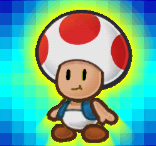
The only Toad in the game, a phrase to never be uttered again after this.
There's a cataclysm approaching as far as stakes goes and I like the eerie sky void, drilling in the urgency for you and characters in universe. This isn't a Bowser kidnaps Peach story obviously, though this is discussed in a tongue and cheek fashion. We have a heavy fantasy focus that's ongoing and not merely historical anecdotes. The villain and one of our main characters are connected (at least once we're done having an amnesia plot). We approach the concept of grief and redemption, complete with a heel turn and a moment of 'is it too late?' and finally sacrifice. You get familiar with our gang of main antagonists and their peculiarities from repeated encounters throughout. I believe that few will complain here.
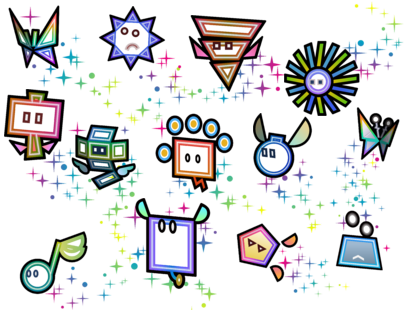
2. Partners: Partners are one of the most beloved aspects of PM:64 and TTYD. They were diverse, fun, and demonstrated well enough who they were by being Mario's mouthpiece for the journey. While Super Paper Mario has more than an average amount, we focus primarily on Tippi, and she gets the talky bits as a result. Using someone other than Mario won't help, because they speak for themselves. What's a Pixl anyway? "A type of fairy" is Tippi's quote on that, with the selection here once being humans like her. Let's break it down:
To conclude, we hit the mark enough to align with the old games. The introductions are always quirky and set up something about their characters, I just don't like how they are a tease. They could have used more dialogue after joining you. Most of what they do come off more like utilities, though I understand that more, as Mario and the rest have their own abilities. Pick the combo that matches your playstyle and have a ball.
3. Hub worlds and chapters: Flipside/Flopside has the 'classic' Paper Mario commonalities, an inn, NPCs, areas to explore that gradually open up, shops, and portals to the chapter levels. The levels all have lore behind them, helped out somewhat by the locations being removed from the Mushroom Kingdom. In the worlds there are sometimes towns within the ‘Chapters’, smaller hubs. These have less going on compared to previous games due to the 2-D perspective, but they exist.
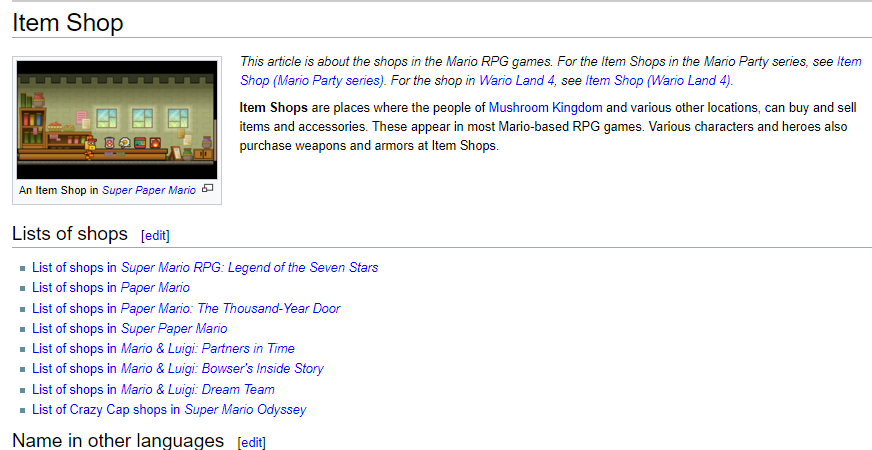
Take note of what is missing here.
4. The shops,recipes, badges or equivalents: What would an RPG be without some sort of shop system? There are several in all three of the first games, each selling different things at different costs and accepting buybacks at various rates. Initially you can cook with a single item but then the player is allowed to combine items for more complex recipes. There are two cooks with different catalogs, Saffron and Dyllis. As in PM64 and TTYD there is some work involved filling out all recipes for max completion. SPM lacks badges, but the collectible Catch Cards are a near equivalent. In addition of behaving as a bestiary they make you do extra damage on the enemy.

Designs in TTYD and SPM range from unique creations to edgy Deviantart OC recolors. Okay that's mean. Sorry.
5. The Pit of 100 trials and other challenges: In TTYD it's a longish journey filled with dread the deeper you get. It's just you, the enemy, and a pipe to the next level if you win, with a few prizes and wussy escape pipes here and there. Super Paper Mario redesigns the whole thing and feels like a party by contrast. You beat up an assortment of enemies in a large room until you find the key. Mind the time limit. The harder Flopside version introduces 'dark' enemies who are only silhouettes. Both are endurance tests either way, with a fitting conclusion of either slaying a dragon or.. yourself?? I'm also not sure why they're so proud of the SPM version that it has to be played thrice. SPM also has the Sammer Duel of 100 challenge. Defeat warriors to win fantastic prizes. And by that we mean catch cards. You were collecting those right? Fun fact, this can only be won once.

6. Unique bosses: The first two games have a variety of bosses that are more than just ‘enemy' but bigger (though they are often big enemies). There are some repeat fights in both, but for the most part they change it up usually. A deliberate decision in SPM to have you encounter Count Bleck's minions often, with the fights getting harder at least in theory. While I like the previous implementation more I can't call this a flaw, because SPM is going for character focused and it is. There's good ideas and designs here, I just forget about a lot of them.
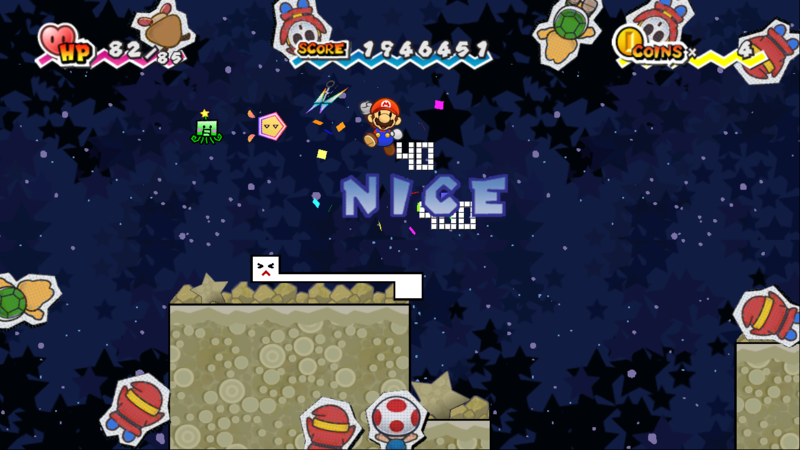
The sellout crowd (prior to suffocation)
7. Action Commands and RPG mechanics: In Paper Mario the player is greatly encouraged to use the prompts to increase attack effectiveness. Super Paper Mario will primarily require platforming skills, but items can require action commands, usually pressing something or shaking the remote. Yeah, they threw that in. I respect the attempt. 'Stylish' moves can be executed after jumping on enemies, you'll get extra points and this behaves like experience. This going up can increase health and attack. The audience members are a visual affect, no freebies or stage hazards. Again it's implemented a little weird. Defense isn't really a thing, and we don't have Flower Points, Star Points, or guarding. Beyond that SPM is more action and adventure, but let's give credit for the clear attempt to hybridize it.
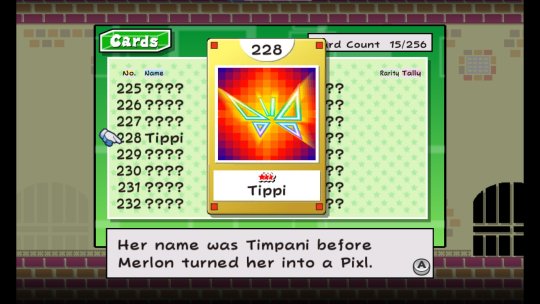
Some include spoilers.
7. Enemies and tattle log system: SPM has an eclectic bunch. Like previous games foes have different colored variants with the most elite enemy that's entirely blacked out. The Mario enemies are a bit basic and related directly to Bowser as they have been brainwashed by Bleck (also indicated by the sun glasses on Koopas). The native Flipside enemies are interesting and abstract, maybe not the most memorable besides a few though.
If there is an area Super Paper Mario does not skimp on it is the Paper Mario bestiary. Tippi gives information by tattling but so do Catch Cards that you collect for every enemy and even NPCs. The catch card entry differs from Tippi's commentary. Collecting all of the cards is a mighty task but they throw in characters from previous Paper Mario games as cameos.

It's relevant I swear. (click for bigger)
0. Music: I think the series has some hits, especially in the first game which is stronger even than TTYD to me in the music department. SPM is hit or miss. Flipside's town music sure drones and gets in your head, but not quite like Rogueport. A few songs annoy me a little however: the theme songs of Pixls joining you, the mellow one that plays during an important story part, and a couple of other things. We rank this zero because the general consensus is that later games remained strong with soundtracks, so there's little to defend or prove here.
Super Paper Mario is oft blamed for what happens next with the franchise and there bits of truth in that. It made radical changes and many were relieved to hear that the series would embrace turn-based gameplay again. Great? But what about Shigeru Miyamoto's thoughts and that Japanese Club Nintendo poll stating that 'story wasn't important'? That's really another can of worms. Let's just evaluate how Sticker Star, Color Splash, Origami King do by the same metrics:
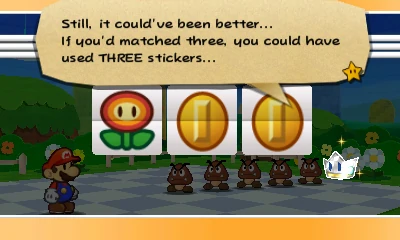
Listen, I'm trying to defend you here..
1. Story, characters, and themes: Sticker Star has a simple plot and a smaller cast. Bowser crashes a Sticker Fest event that we made up for this game, and now baddies in the worlds surrounding Decalberg are powered up and crazy. Kersti, the guardian of the Royal Stickers becomes Mario's partner. Armed with a sticker book, they are off. A very major world building tweak is that we heavily emphasize the 'paper' part of Paper Mario. Stickers are the only way to fight and the characters are often generic enemies or Toads, though to be fair we do distinguish a small handful along the way. Bowser Junior and Kamek join PM canon to torture you in some decent fights. We shed the rest of the fantasy concepts. There is no talk of prophecy or background that goes beyond a 'humorous' quip, even in a few spots where you think there would be. The closest we get is the fact that in this game only (as you'll see) the people (or Toads at least) of Mario's world have no clue what non-paper real-world objects are. That's why they're 'Things'. Maybe it's meant to be a gag for reading the museum entries but this conflicts with world building, as characters like Goombella from TTYD exist still..
I know it's a shock, but what I'll defend the most here is.. Kersti! But just a little. Impetuous and snappy, she's capable of self reflection and mellows by the end, just in time for her sacrifice during the boss fight with a bunch of 'surprise' except not really stages. (At least SS got that series staple right.) My theory has always been that her fan backlash was more harsh because she is the only companion and there's no one else to balance it out. Not everyone has to be a fanboy/girl of Mario after all, and in universe she's supposed to be a more reserved and dignified (at least in her opinion) character. What's not okay is that her lackluster at times ability to give hints to our guessing game puzzles. She also doesn't tattle on enemies. Good luck guessing.
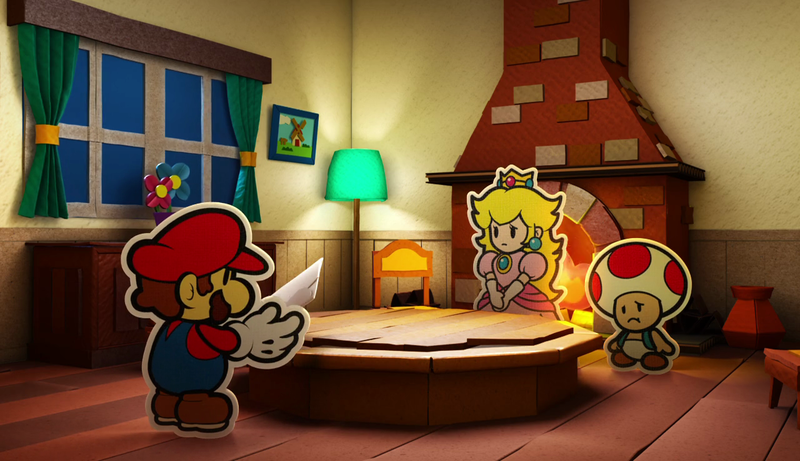
Dear Mario... Good news. We converted your home back into 3D from Super Paper Mario, but we had to remodel it for a third time and we misplaced those partner portraits.
Color Splash: Many decisions made here are unambiguously a response to flaws or 'flaws' (see my comparison articles linked far below) of Sticker Star and that's great. Mario has a strange letter pointing to Port Prisma, our hub for this game. This time Bowser might not be guilty, as he mixes up paint without knowing that Black Paint was the devil. In spite of that his army and now Koopalings will support his color draining ways. This is about to be very subjective I know, but the Koopalings are placed oddly and some characterization I disagree with. The fights also have one issue we'll get into later. A lot of NPCs are Toads again. They do have a little more character and other species show up too. Your partner Huey is enthusiastic to work with you, contrasting Kersti. The world of Color Splash plays heavily on paper like Sticker Star, just with more absurdity. It's not lore heavy, but the locations and scenarios you encounter are exciting, plus the comedy is less forced in my opinion. It could still be less on the nose, but that's me being an oldhead.
Origami King: Let's take everyone people have been snarky about, the paper, the Toads and let's play it for drama. That's PM:OK. King Olly wants to refold the world into origami, which is presented as being akin to death and zombification. This is very late proven false, but the gravity and the urgency of the situation is legit. King Olly has a Freudian excuse, not unlike Count Bleck. He hates the Toad Craftsman that 'defaced' him by writing on him, and now millions (of Toads) must suffer. Fortunately his sister Olivia is a sweetheart, holding onto the hope that she with Mario will snap him out of it.
We return to using Toad Town as a hub, and other locations are little more down to Earth from CS, still exciting to explore. The dialogue, motivations, etc are excellent while keeping with new school Paper Mario restraints. Having the villain and your companion being brother and sister I felt also gave it a different angle. Any NPC character not folded is on your side, so there a big bunch of NPCs you can speak to in this game. It's not over the top like CS, but funny enough.
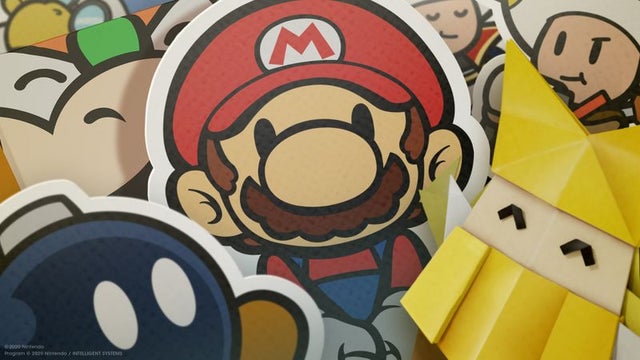
2. Partners: In the final game we have none for Mario. Kersti allows Mario to use a Battle Spinner and give himself up to three moves. That's all the combat she can contribute. On the field she tattles and gives hints.. badly as we've discussed and lets you materialize the correct sticker or type of sticker to solve a puzzle. Apparently she keeps track of how many stickers you use during boss fights alone. I never got the point of this mechanic besides annoying you. There's no reward for being as optimal.
Huey is tied to the Mini Paint Stars the way Kersti was to the stickers. He teaches Mario how to battle with the cards that replace stickers and allows usage of the Paint Hammer. Plot wise he can absorb large amounts of paint and physically hold, or attempt to hold Mario's body. Lastly, he can give hints and lets you wring out Thing objects to turn them into cards. Because Color Splash's structure is less Thing Sticker puzzle solving oriented like Sticker Star, faults with his ability to give hints don't come up much. The paint can dodges that bullet... On a curious note: Huey is a normal non-paper 3D object when you first meet him. He then makes himself paper. The Rescue Toad Squad occasionally help you out throughout the game but you don't directly control them.
Olivia in Origami King lets you use the Magic Circles and 1000-Fold Arms technique either on field or in battle. She can also transform into four Vellumentals after you defeat them. You can throw confetti to cover holes in the universe. Lastly, she gives hints. There's a similar thing to Color Splash in that due to the game's structure you won't need a lot of outside help. What you are to do is always revealed in the game whether via Olivia or NPCs or hints lying on the battle stage ground. -But if you needed a hint I always found her helpful. You have partners in battle. Bob-omb (Bobby), Spike, Bone Goomba, Professor Toad, Kamek, Bowser Jr, and Bowser will at some point(s) accompany you. You cannot directly control them but they all do effective damage and there is an item to equip to increase their effectiveness. Of course this is not to be confused with the classic partner system. Aside from Professor Toad they don't have field abilities. There are other characters that will accompany or help Mario at various points. You wish the partners would stick around longer but it was a step in a better direction.
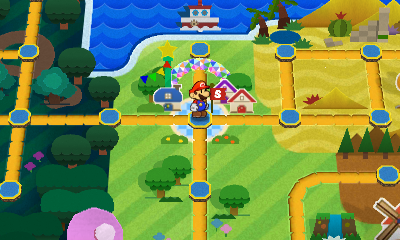
Level by level mapping. Also note the auto-save.
3. Hub Worlds: Sticker Star's Decalburg has an item shop, the Sticker Festival stage that you can’t do much with, the area where you convert things into stickers, and a good tune. Port Prisma offers a little more ostensibly but it’s still not that much going on aside from vaguely calling to mind the layout of Rogueport. There are similar things, the museum, a battle training place, a place to get your thing cards, a shop... The only residents are the Toads and the size feels smaller. Being fair these two games work on a level select map system. The hub town does not connect anything. In Origami King however Toad Town does connect all the worlds like a classic Paper Mario game. There is no level select and you use shortcuts via pipes. Again there is a shop, museum, training area, and regular citizens living around, this time not only toads!
4. The shops, recipes, badges, or equivalents: All three have shops, though not equal. In Sticker Star the item shops are nearly made obsolete by the sheer amount of stickers you find in the field for free. Prisma Cardware is a similar thing, a shop with basic cards if you need them in a pinch. In Origami King you do not have a consumable system but your extra weapons do degrade and you may be tempted to occasionally buy something. Still a lot of what you want you can get for free. Now there was a lot of shopping you didn't have to do in the earlier games either depending on your play style either, so I can't be super harsh. In Origami King there are accessories that work like badges. You can have multiple enabled in various categories that increase health during battle, add to the battle timer, alert you to secrets, or do cosmetic things. These must be bought along with some treasures so some money must be spent here. None of these three games have any recipe system.
All three games have a museum to perform some function of a bestiary, but primarily to hold collectibles, extras, and soundtracks. In Sticker Star this is your only source to estimate the damage values and attributes of some of the thing stickers. There is an enemy and music gallery as well. For some reason you are charged and given limited time to eavesdrop on those basic old enemies! The stickers are separated by category but they made the room very large inexplicably. The sticker descriptions are sometimes a gag, obfuscating what some stickers actually do. Color Splash fixes that with the Prisma Museum. The Battle Cards are stored here along with the art and sound gallery. Cleaner presentation overall but no concrete numbers like there should be on damage output, health, etc. The Musée Champignon is in Toad Town in Origami King. You don't donate anything, which might have been tedious to some previously anyway. Treasures you collect are added and Toads rescued unlock art. Fishing and enemy battling logs that info. Lastly, you complete objectives to earn trophies. Streamlined and clean.
5. The Pit of 100 trials and other challenges: Sticker Star and Color Splash had a prime opportunity for this sort of challenge since their battle systems depended on inventory management. There are things like Snifit or Whiffit, but those are not about dungeon crawling. Origami King has a boss rush mode where they regulate your health and items. The Battle Lab also has modes challenging you with handling the battle field rings. That's as close as they get. No dice, unfortunately.
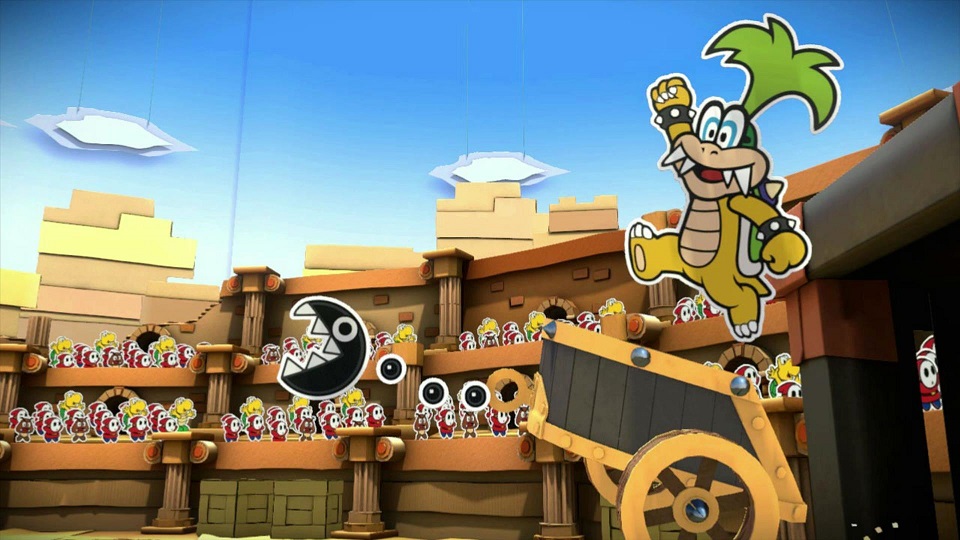
Depth and strategy? Eh, but we can't argue that the presentation isn't zany and polished.
6. Unique bosses: In Sticker Star your enemies are main series or a larger regular enemy. That doesn't mean our fights are boring, and effort is put into using different mechanics for each one, culminating into Bowser's fight where you need to combine strategies. I just don't like that it's almost too easy if you play by the rules and exploit the weaknesses, or annoying and grindy if you choose to not use Things. Something in the middle please. We include a 'the boss in invulnerable until a cut scene and then you can hurt them again' phase. Kind of impressive they kept that tradition. It's too bad there is no final level, just a carpeted hallway with Kamek in your way very briefly.
In Color Splash you have main series Koopalings, love it or hate it. The fights are fun if even more railroaded than Stick Star, because you are now required to use Things. I make more points on this on a page here. The other real boss is the Black Paint, created when all the normal paint colors mix. While possessing Bowser it sounds very impersonal and flat. For some reason no regular Bowser minion has issue with their King being possessed. At one point it impressively levels a large area, but Huey fixes that rather quickly so maybe not so much.. The final fight is entertaining, playing with the concept of how much paint you are knocking off of Bowser. I don't care for the fact that at the final phase of the fight lasts for a finite time and then it's game over, though.
In Origami King they step it up with the Legion of Stationery. These characters effectively hold godlike power over mere paper beings, scribbling all over it childishly, stamping your brains out disturbingly, and slicing you in half brutally. Watch out. There are also the Vellumental fights, elemental deity forces. Residing in temples they don't have much character as they are animals. We drop the 'use the right item' gimmick thank goodness, and instead force you to be on your toes and develop ad hoc strategies during the dynamic fights. Some are certainly easier than others. Overall it does feel more RPG like. There are real time battles here and there with a mixed ensemble of freaky Paper Macho minions. I loved that. The King Olly fight plays with familiar concepts except for some motion controls that may fluster you the first time. It has a time limit too at some sections. I think Origami King is closest to classic games in this area, but if you don't mind main series characters I suppose Color Splash is okay as well.
Designed for post SPM games. Is it fair? Yes and no.
7. Action Commands and RPG mechanics: In all three games action commands are reduced to the most rudimentary level where you press A. In Sticker Star only Mario is on the field. He has one action unless out complete the Battle Spinner where you can use two or three more stickers. You automatically attack the first enemy on field. You cannot select otherwise. Your stickers are arranged in you album on the bottom screen. Your pages increase after defeating a main boss. Stickers have a single action per sticker. There are various qualities such as being shiny or flashy that makes it stronger. A larger sticker is stronger too but physically takes up space in your album. If a sticker is unused at the end of the battle but you stuck it up for usage it's wasted. Stickers either attack or do something defensive for you. You are rewarded for clearing all enemies in your first turn. You may defend against an enemy attack by hitting A but there is no super guard so if you leave an enemy standing there's no avoiding damage. You can flee a fight by spamming A or using a secret door item. Enemies have their health bar combined but eventually you can do some mental calculations. There are status effects here like poison or soggy or crumpled but the game goes out of its way to not explain this stuff. That's... it!
In Color Splash you use cards in place of stickers. Some cards now have more than one use and a card being painted or not affects to damage output. They have similar attributes but always take up the same space in your album. How many you can use will increase as the game progresses. There are enemy stickers that create a temporary partner to fight for you but these don't work with bosses. Thing cards behave like before. Again you can defend with A and attempt to flee a battle, maybe. The compass item will ensure this. Enemies now lose their color to indicate health. Takes a bit to get used to. I'd prefer to just have a number, wouldn't you? A lot of the previous status effects return.
In Origami King uses a timed ring system in front of a live audience. At the start of normal battles Mario is in the center and the enemies are in predetermined spots on the outside rings. You have a set amount of moves to arrange them correctly. You have hammer and jump by default and you equip stronger boots and hammers as weapons that degrade by usage. You also have items like mushrooms and fire flowers on a separate menu. You have one action unless (in boss fights) you arrange the field to land over a panel that gives you an extra turn. You arrange the rings with enemies correctly and you gain extra damage output. In a boss fight you are outside the ring and the boss is in the center. You then arrange a path to the boss while crossing necessary panels that will allow you to use the right attack. Even the angle in which you approach the boss can matter. Various boss fights bring new gimmicks and hazards to the battle stage. The final fight with King Olly also has unique characteristics, if a bit sudden. You can flee battles, or ask Olivia a question (which pauses the timer), pay for more time to complete the puzzle, or pay coins for your Toad audience to help. They may arrange the panels for you, damage enemies, or toss health on stage. Battle accessories can give you free health, increase the amount of time you have, and increase your defense. You see the health of bosses but not enemies but they will physically indicate low health. We don't have the traditional status effects but some enemies can mess you with nonetheless.
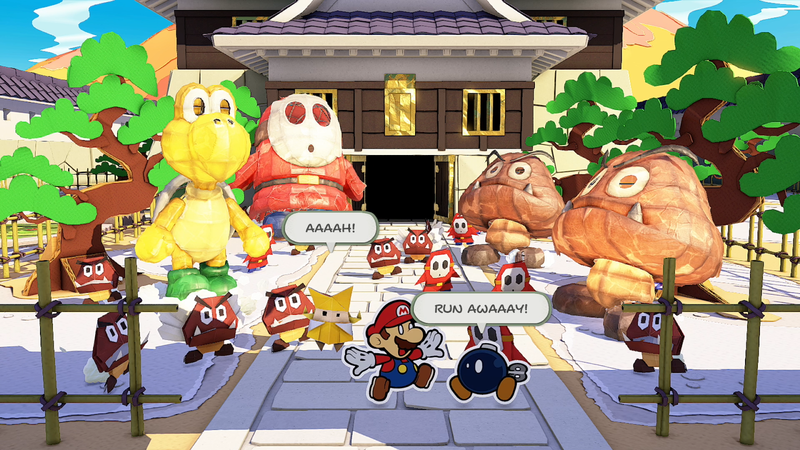
See ya! Just avoiding the flames!
0. Music and conclusions: I'll make this as short as the other section. Sticker Star has a nice jazzy theme I can imagine even after not playing it in a good while. Music is a strong point there. Color Splash and Origami King also has some nice hits. I hope I've proven that even if you dislike modern Paper Mario there are at minimum slivers of good in them. Sticker Star does cut the experience down I admit. Just view it as a short portable romp and everyone, even Nintendo realized it was too bare. It's not the sole reason Paper Mario changed. Research will show that it was inevitable as it started early in development as a more traditional game but was changed to what we have now. There is at least some fun self imposed challenge potential if you don't use thing stickers. Color Splash is a more complete game and does the consumable battle system about as well as it can be done. It has lots of funny moments and is beautiful to look at and a genuinely fun if not hugely impactful experience overall. Origami King gives us a more nuanced if short adventure I feel with better more grounded characters and plenty of emotional moments. Partners and a move away from card/sticker battling are other features that may attract old school fans. The puzzle ring battle system isn't for everyone but the way they handled world building and incorporated the world of paper into the plot puts it above the others in my opinion.
-Comparing Thing stickers in Sticker Star and Color Splash
-Unexpected ways in which Sticker Star is better than Color Splash
-Dark elements in Sticker Star (humor)
-Character design in Paper Mario
-Something mundane but odd taken out of new Paper Mario games
